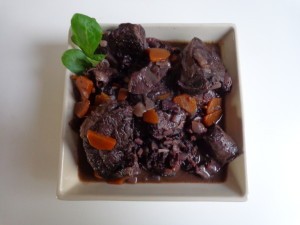Beef braised in red wine, Burgundy style
Boeuf bourguignon has taken on mythic proportions outside of France, largely due to Julia Child, who elevated what was traditionally simple country fare into a culinary art form. But how complicated does this hearty beef stew have to be? In Burgundy itself, everyday chefs (and even restaurants) continue to make their bourguignon in traditional ways – without necessarily adding mushrooms, pearl onions or butter.
But which cut of beef to choose? A great bourguignon usually uses a combination of cuts. In France, cuts that are typically used include basses-côtes, gîte à la noix and tranche – which translate more or less, for an American cook, as chuck, round steak and rump roast. As these are cuts that require lengthy cooking to achieve tenderness, be sure to begin your bourguigon in plenty of time. The preparation takes about 20 minutes, and the stewing about 3 hours.
As for the wine, the quality will affect your success with this dish, so it’s worth paying for a decent red. But it doesn’t have to be Burgundy, which has become prohibitively expensive for use in cooking. I generally use a Rhône wine or merlot from southern France. Any hearty red will do.
By the way, this dish is even better the next day!
2-1/4 pounds (1 kilo) stewing beef, as described above
2 medium onions
1 large carrot
1 large garlic clove or 2 medium cloves
1/4 pound (100 g.) thick-cut bacon
1 tsp. plus 1 tbsp. olive oil
1 tbsp. flour
1 sprig thyme
1 bay leaf
1 bottle hearty red wine
1/2 tsp. salt
freshly ground black pepper
Cut the beef into large cubes, about 1-1/2 inches (4 cm) per side. Remove any extra fat. Set aside.
Peel and chop the onions. Peel the carrot, cut in half lengthwise and slice into half-rounds. Peel and finely mince the garlic. Set aside.
Remove the rind from the bacon if necessary and cut into lardons (thick sticks about 1/4 inch wide and 1 inch long). Sauté lightly in 1 tsp. olive oil. Drain and set aside.
In a heavy bottomed stewing pot, heat 1 tbsp. olive oil to sizzling. Sauté the cubed beef in batches until browned on all sides.
Add the onions and carrots and cook until the onions begin to wilt. Add the garlic and sauté briefly. Add the bacon. Sprinkle with the flour and cook for five minutes, stirring so that the pieces don’t stick.
Now add the wine and stir, scraping the bottom of the pot to incorporate everything into a smooth sauce. Add the herbs and seasonings.
Bring to a simmer and cook for 3 hours, or until the meat is tender. Turn off the heat and allow the stew to rest.
Before serving, adjust the seasonings and reheat gently. Serves 4-6.
What to serve with the bourguignon? Mashed potatoes, boiled potatoes or macaroni gratin are traditional in France, while fresh pasta like tagliatelle is also commonly served. More innovative would be a purée of cabbage or another vegetable purée, or simply green beans. And of course a great wine, if not Burgundy then another full-bodied red like a Rhône wine or a Bordeaux.






try adding beef stock with the wine. It rounds it out.
Hi ND. Thanks for commenting — even incognito! By all means go ahead and add beef stock if you like, providing it’s homemade and not a bouillon cube, as that would add an undesirable chemical tinge to the dish. There are many many variations on boeuf bourguignon. Some recipes call for beef stock, others chicken stock and some, including this recipe, don’t call for stock at all. It’s up to the chef. In Burgundy, where I had a summer home for many happy years, they tend to leave out the stock and count on the flavors of the beef, wine and veggies to round out the dish. Bon appétit!
Mine turned out bitter and winey? Is that supposed to happen
No, Jack — that is not supposed to happen. And I can’t imagine why it did, unless you used an inferior wine. There is nothing bitter in the ingredients. Better luck next time.
Would you please put me on the distribution list for your blog. Thank you.
Adelbart (Bert) Banks
You can sign up by simply clicking the little envelope at the top of this page (or any page on the site). Then follow the instructions. You will receive an email, and you need to click on the link in the email to finalize your blog subscription. Thanks for your interest!